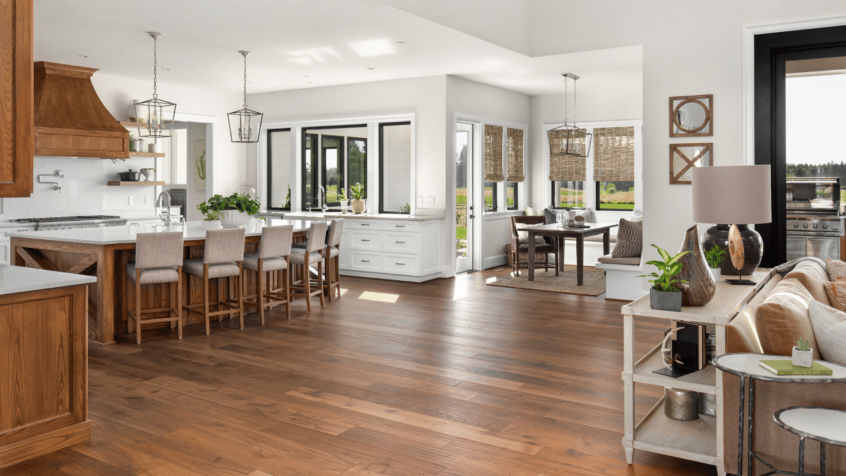Who doesn’t love the look of wood floors? They’re timeless, stunning, and a great way to add value to your home. No matter what your home’s aesthetic is, you can achieve any look with a nice set of hardwood floors. So, why doesn’t everyone have them? Traditional hardwood is very expensive and prone to damages. Due to the soft, natural fibers of the wood, this flooring type shows dings, scratches, and is at risk for bloating and shrinking when not in the ideal climate.
However, if you’re dying to achieve the classic effect of hardwood floors, there’s a stronger and more affordable option. Enter engineered hardwood! A revolutionary construction, these floors contain 100% real wood in the top layer to give the aesthetic of traditional hardwood. To increase durability, they also feature a plywood base, allowing them to withstand temperature changes and humidity.
So, if you’re on the hunt for a classic, long-lasting set of hardwood floors, engineered is the way to go. To prolong the life and look of your flooring even further, consider installing distressed engineered hardwood to your home. Here’s what it can add to your space:
A Unique Appearance
A visual treat, distressed wood offers individuality and intrigue. Compared to standard smooth wood flooring, there’s a lot more to feast your eyes on with distressed styles. There are several tools and techniques used to achieve the distressed look. Practices such as embossing, wire brushing, sculpting, scraping, marking, etching, colour washing, sanding, and liming are used. As a result, the planks feature knots, dents, and intentional scratches to create a weathered effect.
Charming and warm, the ‘imperfections’ in the wood play off the light, adding further dimension to your space. The uneven surface creates the perfect canvas for highlights and shadows, giving unique hues to every room of the house. If you want to add richness and depth to your home, distressed engineered hardwood is the way to go.
Made to Last
While we touched on the durability of engineered hardwood, there’s more to be said for the strength of this flooring type. What makes it so strong? While the top and bottom layer are 100% hardwood, the core takes the floor from good to great. Made from layers of tightly compacted plywood sheets, the grains crisscross in alternating directions. Not only does this make for a strong plank but a stable one.
An issue many people face with traditional hardwood is its tendency to shrink, swell, and warp. This is due to changing climates throughout the year. However, even in highly humid areas, engineered flooring is constructed to resist temperature changes. Making it a suitable option for kitchens, bathrooms, and laundry rooms. Furthermore, any acquired scratches will blend with the distressed design, helping your floors look better with time.
Low-Maintenance
Compared to other flooring types such as carpet and tiles, engineered hardwood floors require minimal maintenance. Since carpets are prone to staining and tile grout is a nightmare to keep clean, regular sweeping or vacuuming is all that’s needed to keep engineered wood looking like new. Depending on the activity of your household, occasional deep cleans with a specially formulated floor cleaner is recommended.
Furthermore, the distressed finish allows any additional scratches, dings, or dents to blend in seamlessly. While this flooring type is resistant to all sorts of damage, an added cushion of protection is always nice. A new scrape here or there will only add to the unique texture of the floors.
Durable but not bulletproof, avoid using these products when cleaning your distressed engineered wood floors:
- Carpet setting on the vacuum cleaner. The bristles can damage the wood; therefore, the hardwood setting is recommended.
- A wet mop. While engineered flooring can withstand damp environments, excess water can damage wood and should be avoided when possible.
- Cleaners containing harsh chemicals. Ingredients such as ammonia can damage the finish on engineered wood floors. Rather, opt for a hardwood-safe cleaner that isn’t waxed based and doesn’t contain oil soaps.
- Steel wool brushes and scouring pads. Distressed hardwood is designed to include marks and scratches, however, using rough materials to buff out scuffs can damage the finish. A microfiber cloth is a great alternative if needed.
What’s Next?
If you’re searching for the perfect set of versatile, durable, and stunning engineered hardwood floors, our showroom is stocked with the largest selection in the country. Compared to other flooring companies, we buy our products direct to save you money without sacrificing quality. Drop by our King of Floors flooring showroom in Surrey BC today!
🔍 Explore Our Collections
Buy direct & save. 85,000 sqft MEGA WAREHOUSE. Over 300 products in stock!
Visit our showroom today for unbeatable prices and quality products!

